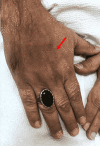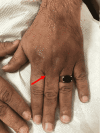Idiopathic Atrophoderma of Pasini and Pierini: A Case Report and Literature Review
- PMID: 35936167
- PMCID: PMC9351397
- DOI: 10.7759/cureus.26571
Idiopathic Atrophoderma of Pasini and Pierini: A Case Report and Literature Review
Abstract
Atrophoderma of Pasini and Pierini (APP) is a rare cutaneous condition of unknown etiology, predominantly affecting young women. It is a dermatologic disorder characterized by hyperpigmented depressed patches of dermal atrophy. Patients usually present with single or multiple asymptomatic, violaceous, and sharply demarcated areas of depressed plaques; of note, unlike morphea, there is no surrounding erythema or induration. In this report, we discuss a case of a 43-year-old South Asian male patient who presented with an eight-month history of multiple asymptomatic, and depressed bluish-brown plaques that had appeared over his body. The clinicopathological correlation was consistent with a diagnosis of idiopathic atrophoderma of Pasini and Pierini (IAPP). We also engage in a review of the literature on IAPP.
Keywords: atrophoderma; dermal atrophy; iapp; morphea; pasini and pierini.
Copyright © 2022, Hubail et al.
Conflict of interest statement
The authors have declared that no competing interests exist.
Figures





Similar articles
-
Idiopathic Atrophoderma of Pasini and Pierini: Response to Mycophenolic Acid Treatment.Cureus. 2025 Jan 14;17(1):e77439. doi: 10.7759/cureus.77439. eCollection 2025 Jan. Cureus. 2025. PMID: 39949423 Free PMC article.
-
BULGARIAN PATIENT WITH ATROPHODERMA OF PASINI AND PIERINI- DESCRIPTION OF A CASE AND SHORT UPDATE.Georgian Med News. 2023 Jul-Aug;(340-341):227-231. Georgian Med News. 2023. PMID: 37805902
-
Atrophoderma of Pasini and Pierini.2023 Aug 7. In: StatPearls [Internet]. Treasure Island (FL): StatPearls Publishing; 2025 Jan–. 2023 Aug 7. In: StatPearls [Internet]. Treasure Island (FL): StatPearls Publishing; 2025 Jan–. PMID: 30085611 Free Books & Documents.
-
Atrophoderma of Pasini and Pierini in a young adult: a case report.Acta Dermatovenerol Alp Pannonica Adriat. 2019 Mar;28(1):45-46. Acta Dermatovenerol Alp Pannonica Adriat. 2019. PMID: 30901070 Review.
-
Idiopathic atrophoderma of Pasini and Pierini.Int J Dermatol. 1984 Dec;23(10):643-5. doi: 10.1111/j.1365-4362.1984.tb01222.x. Int J Dermatol. 1984. PMID: 6396245 Review. No abstract available.
Cited by
-
Idiopathic Atrophoderma of Pasini and Pierini: Response to Mycophenolic Acid Treatment.Cureus. 2025 Jan 14;17(1):e77439. doi: 10.7759/cureus.77439. eCollection 2025 Jan. Cureus. 2025. PMID: 39949423 Free PMC article.
-
A Clinical Case of Idiopathic Atrophoderma of Pasini and Pierini With Literature Review.Case Rep Dermatol Med. 2025 Mar 14;2025:8886954. doi: 10.1155/crdm/8886954. eCollection 2025. Case Rep Dermatol Med. 2025. PMID: 40123740 Free PMC article.
References
-
- Idiopathic atrophoderma of Pasini and Pierini. Pullara TJ, Lober CW, Fenske NA. Int J Dermatol. 1984;23:643–645. - PubMed
-
- Idiopathic atrophoderma of Pasini and Pierini. Canizares O, Sachs PM, Jaimovich L, Torres VM. AMA Arch Derm. 1958;77:42–58. - PubMed
-
- Atrophoderma of Pasini and Pierini: a clinical and histopathological study. Saleh Z, Abbas O, Dahdah MJ, Kibbi AG, Zaynoun S, Ghosn S. J Cutan Pathol. 2008;35:1108–1114. - PubMed
-
- Atrophoderma of Pasini and Pierini: clinical and histopathologic findings and antibodies to Borrelia burgdorferi in thirty-four patients. Buechner SA, Rufli T. J Am Acad Dermatol. 1994;30:441–446. - PubMed
-
- Idiopathic congenital atrophoderma of Pasini and Pierini. Bassi A, Remaschi G, Difonzo EM, et al. Arch Dis Child. 2015;100:1184. - PubMed
Publication types
LinkOut - more resources
Full Text Sources
